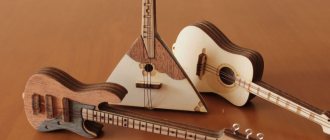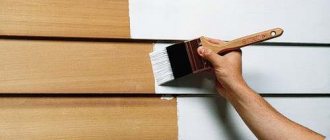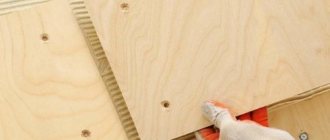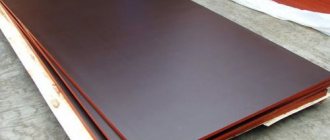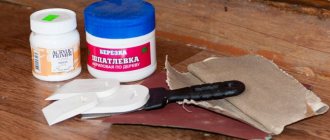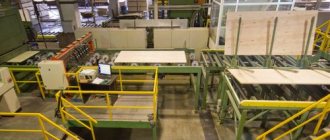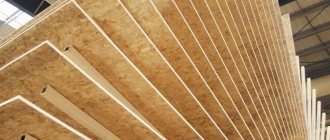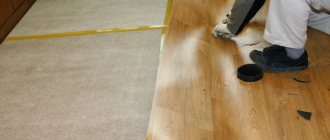Plywood is classified as a natural material, so it can change its state, as well as shrink and expand as a result of exposure to high humidity or fluctuating temperature changes. As a result of unfavorable conditions, the veneer layer will be covered with cracks, which can expand and contract due to changes in moisture conditions. To avoid troubles, it is necessary to apply a primer against moisture and apply various paints with favorable properties for plywood. This is why primer for plywood is so important.
Is priming necessary?
For a number of reasons, priming is a necessary process when using plywood. Achieving the desired result will depend on its composition, for example, the presence of an anti-fungal component in it.
But, regardless of the composition, applying a primer during processing will achieve results such as preventing moisture from entering the plywood and, as a result, swelling, deformation and rotting.
It also allows you to achieve an antibacterial effect, increases the strength of plywood, and stops its cracking.
What to look for when choosing soil
Let's look carefully at the composition, highlighting the components and properties we need.
In this case, the following will be important for processing:
- compliance of the selected coating with the required surface; in other words, it should be designed for plywood or wood;
- at the same time, you can use a composition intended for chipboard, which will ensure adhesion of the surfaces of the base and paint;
- it is necessary to note the compatibility of the primer and subsequent cladding: paint or varnish;
- it is important not to miss the water-repellent component if the building materials that have been or will be used already contain it;
- and the very presence of a water-repellent component is due to the further use of plywood outdoors under precipitation and sunlight;
- even if the plywood will be used only indoors, you need to pay attention to the expected humidity in it;
- It is highly recommended to choose a product with an antibacterial component, which will protect the plywood from fungi, mold, and rot in the future;
- Water-based acrylic or alkyd compositions are recommended for use;
- It is also possible to use nitrocellulose paint NTs-48, NTs-1227.
Why is it necessary to prime?
There are several reasons why it is necessary to coat a plywood base with a primer:
- Priming plywood increases the resistance of wood to the destructive effects of moisture, reduces the absorption of water by wood and prevents swelling and deformation. Subsequent coating with water-repellent paints and varnishes increases the wood's resistance to water.
- Primer and paint, which have bactericidal properties, applied to a wooden base prevent rotting.
- The primer prevents wood from cracking.
- Using a primer for painting, you can protect plywood from the formation of mold and fungal infections. This effect is achieved thanks to the commercial availability of primers with specific additives.
How are soils classified?
Each manufacturer strives to introduce something special into the composition of its material, different from others, for example: adding coloring or bactericidal components, fixatives, components that create viscosity or, conversely, quick drying, and other specific properties.
But what all soil formulas have in common is the presence of film-forming substances: oils, adhesives, polymers, and other specific components.
Compositions are divided depending on the main material into:
- alkyd;
- acrylic;
- oil;
- mineral.
Let us note once again that it is very important to choose which set of properties is needed in this particular case, and only after that proceed to the final choice of product.
This will be the key to the success of further use of plywood.
What are the key features of different compositions of certain soils?
Acrylic primers
The name itself suggests that this type of primer is based on acrylic, and accordingly has characteristics corresponding to acrylic: it dries quickly, does not have a pungent and unpleasant odor.
After applying this type of product, a protective film is formed that penetrates all irregularities and roughness of the surface, which, in turn, mechanically protects this surface.
To enhance this effect, it is recommended to apply a paint material compatible with this type of primer.
Alkyd primers
This type of primer is recommended for untreated plywood and covers it perfectly. Creates a durable film that protects and strengthens the surface, facilitating the application of paints and varnishes. Impregnation can be carried out one or more times.
But there is also a minus: the drying speed of alkyd primer is much lower than acrylic, and it also has an unpleasant toxic odor. However, the result is a high-quality impregnated surface.
Epoxy and polyurethane primers
Products made on the basis of epoxy resin and polyurethane require a special approach to application; therefore, before purchasing and using the material for processing, carefully read the instructions.
Shellac primers
Excellent for processing plywood of all types of wood coverings, they are especially suitable before varnishing.
An interesting feature is that shellac primers contain the milky juice of insects.
Phenolic primers
This type of product is often used by the furniture industry, although the phenol they contain is considered unsafe for health.
The low price and high impregnation ability of the material are attractive, which explains its widespread use for processing.
It takes about ten hours for this composition to dry completely.
Drying oil primers
They have a stable water-repellent effect during processing, which makes them widely used for facial work with plywood.
Can also be used for interior decoration.
Styrene primers
Provide a durable film that protects against mold and rotting processes. Compatible well with phthalic and alkyd enamels.
Primer for laminate flooring: types and features of their use
Laminate is a durable, wear-resistant and expensive floor covering. But even it will not last long if you place it on a poorly prepared surface. An uneven floor will mechanically affect the interlocking joints of the laminate, causing them to diverge. This leads to the appearance of cracks, loosening of the coating and its eventual destruction.
Primer functions
The main purpose of the primer for laminate flooring is to ensure adhesion, that is, excellent adhesion of the coating to the floor. Its use helps the laminate adhere more tightly to the base. Other functions of the ground cover include:
- Since the primer fills all the voids, the floor surface is leveled, becomes smoother, the base itself is strengthened, its structure is strengthened.
- The primer ensures ideal surface cleanliness, eliminating minor contaminants - dust, small particles of dirt. Thanks to the binding of dust particles, a better fit of materials occurs.
- When using a deep penetration primer, the moisture resistance of the floor increases, which means the laminate will last even longer.
- Compositions with fungicidal properties protect the floor from mold.
Most professionals agree that the floor still needs to be primed before laying the laminate. This will allow the flooring to show its full properties and will also extend its service life. The soil is selected depending on the type of base and the purposes that the coating should serve.
Base requirements
The basic requirements for the foundation are as follows:
- To avoid swelling of the laminate, the base must be thoroughly dried.
- The surface must be clean, for which it is vacuumed immediately before laying the laminate. Even the presence of small particles, such as sand, can cause a crunching sound to be heard when walking.
- A uniform floor slope of no more than 4 mm per 2 m of the length or width of the room is considered acceptable.
- It is impossible to lay laminate flooring beautifully on an uneven floor. Therefore, you need to first level it. Differences in height cannot be more than 2 mm per 2 m of room length.
We recommend: How to calculate primer consumption per 1 m2 of wall
Violation of at least one of the listed requirements leads to rapid destruction of the floor covering and the need for repairs.
Features of installation on various bases
When laying laminate flooring on a concrete base, you need to make sure that there are no differences. Even small irregularities can nullify all efforts. A self-leveling mixture will help cope with this. The step-by-step process looks like this:
- Small cracks are filled with tile adhesive.
- Apply a deep penetration primer.
- Dilute the mixture to a thick, homogeneous consistency.
- Fill the floor with solution, starting from the highest place. The mixture will distribute itself over the surface. Then you need to further level it with a wide spatula.
- Using a roller, air bubbles are rolled out.
- The solution is allowed to dry for several days.
If the floor has significant unevenness, slopes and cracks, then too much mortar may be needed. In this case, it is best to make a concrete screed. Then it is simply coated with a primer so that it does not crumble during the process.
You need to wait 6-8 hours between applying 2 layers of primer. This will allow the base surface to be well saturated. The soil will reliably hold together small particles of sand and cement. A polyethylene or cork backing is laid on the primed floor. Its purpose is protection from moisture, heat and sound insulation.
When laying laminate flooring on a wooden base, sanding will help smooth out any unevenness. If there is a significant difference in height, OSB boards are used. They are secured with self-tapping screws.
The boards must not be allowed to sag. If this happened due to the incorrect distance between the lags, then it is best to take thicker boards. You can also make another layer of boards, perpendicular to the first. A sheet of plywood is fixed on top. And a primer is already applied to it.
Choosing a primer for concrete
The following types of soil are suitable for concrete foundations:
acrylic façade primer;
acrylic floor primer;
· epoxy primer for concrete floors;
· acrylic primer for slate.
Epoxy compounds are suitable specifically for concrete. They protect the floor surface from moisture and are resistant to most chemicals. To protect against fungus, you can add special compounds to them.
Laying laminate flooring on a wooden surface
The base is leveled using plywood, OSB, GVLV sheets, pieces of roofing felt, which are placed under the logs. For the same purposes, glassine folded in several layers is used.
Before laying the laminate, lay a backing made of natural material, for example, cork. The thickness of the layer is selected depending on the parameters of the laminate. For example, for an 8 mm laminate, take a 3 mm substrate and lay it without overlap. It is not attached to the wall or base, but is only glued with tape.
Laminate panels are laid across the floor boards. And the strips of the substrate, accordingly, are laid lengthwise.
Selecting a primer for wood
It is best to coat a wooden floor with an alkyd or polystyrene primer before laying the laminate. In the second case, it is necessary to ensure high-quality ventilation of the room, since the polystyrene composition contains harmful toxic substances.
Another suitable coating option is shellac primer. It is usually used on freshly laid wood, as well as on coniferous species.
Primer for plywood floors
Plywood has increased moisture resistance. But under the influence of unfavorable factors, the sheet can expand or contract, like other wooden products. To prevent deformation of the laminate, the base should be primed.
A water-repellent primer with special additives is used under plywood to prevent rotting and mold.
The quality of the plywood itself is equally important. It is best to choose FK brand boards with a thickness of at least 1.2 cm. And only if the floor is completely flat without the slightest defects, you can take plywood up to 1 cm thick.
Application technology
First, the surface is vacuumed to remove all debris. Grease stains are wiped with solvent. The surface is completely dry.
Apply the first layer of primer and wait until it dries. Then just apply the second coat of paint. If the surface is too porous and loose, a third layer may be needed.
Preparatory process before laying laminate
The concrete floor is cleaned of debris, remnants of old coating and paint stains. If there are cracks in the floor, they should be cemented. If there are sagging concrete, you should first break them using a hammer drill.
We recommend: Epoxy primer: why it is needed and how to use it correctly
Prime the surface to improve the adhesion of the solution to the floor. Using a level, determine where the beacon slats are located. They are fixed with a solution. Cement mortar is prepared from M-400 cement. It should be thick to better level the surface.
Using the rule, level the solution on the floor according to the beacons. To remove air bubbles, use a needle roller to treat the surface. When the solution dries a little, the beacon slats will need to be removed. The voids after them are filled with solution.
After the subfloor has completely dried, the self-leveling mixture is poured onto the floor surface. They also go over it with a needle roller to eliminate bubbles. The base is ready for laying the laminate.
Preparing a wooden floor without significant differences in level involves scraping. The surface is treated with a scraping machine and a manual scraper. Before this procedure, it is necessary to deepen the nails with a hammer. Laminate can be laid on a leveled surface.
If there are significant differences in level, the floor is leveled using plywood or chipboard. Before laying them, you need to remove the rotten fragments of the old covering and fix the loose boards with self-tapping screws. Sheets of plywood or chipboards are laid offset for reliability. There must be a minimum distance between sheets. They are fixed with hidden screws.
Priming the floor before laying laminate
The primer is applied to a flat, thoroughly cleaned and dry surface. First, the first layer follows, and after it dries, the second. For the first layer, the primer is usually diluted. It must be liquid in order to easily penetrate into all pores and fill microcracks.
PVA will help you save money. It is used instead of a primer, diluted with water in a ratio of 1:2. Usually take 2 liters of water for 1 liter of glue. The composition is thoroughly mixed and used for priming.
Features of laying laminate flooring on an old screed
If the laminate is supposed to be laid on an old wooden base, then you need to check the quality of the boards. Those that have rotted need to be renewed.
If unevenness is detected on the concrete base, the screed will have to be refilled. To do this, use a self-leveling mixture. You need to follow the plan:
- Clean the surface from debris and dust.
- Seal cracks with tile adhesive.
- Apply deep penetration primer.
- Pour the self-leveling screed mortar starting from the highest point.
- Using a spatula, distribute the solution evenly over the entire surface.
- Roll out the floor with a roller.
How to remove primer from laminate flooring
Stains left by the primer can be washed off the laminate with acetone or alcohol. To do this, moisten a cotton swab in a small amount of liquid and wipe the surface. Then wipe the laminate with a damp cloth.
Priming the floor before laying laminate flooring is necessary. This extends the service life of the coating and provides it with an excellent appearance. But you need to choose the right composition and apply it correctly.


